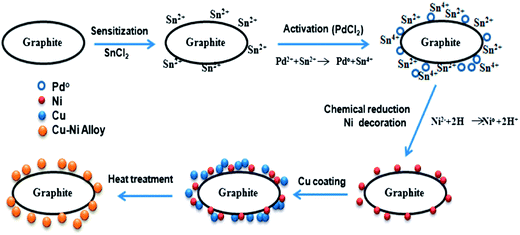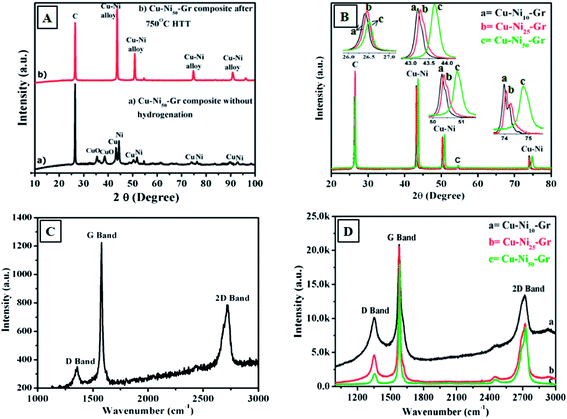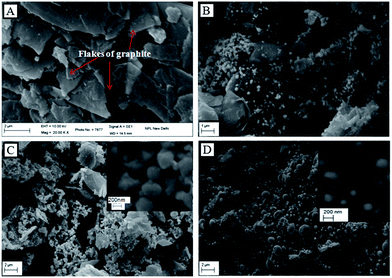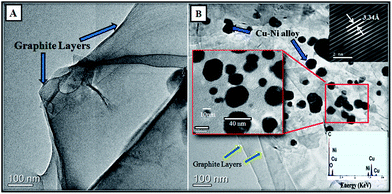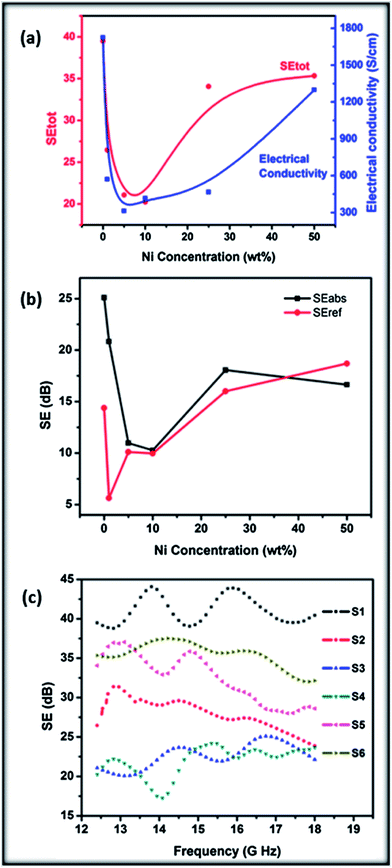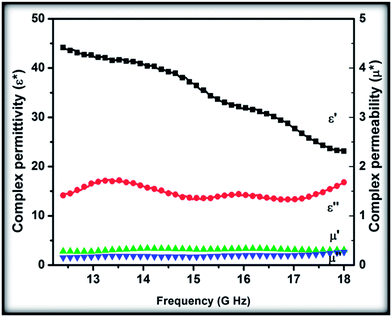Cu–Ni alloy decorated graphite layers for EMI suppression
Saroj Kumari*a,
Anil Kumarab,
Avanish Pratap Singha,
Manjari Garga,
P. K. Duttab,
S. K. Dhawana and
Rakesh B. Mathura
aMaterial Physics and Engineering Division, CSIR-National Physical Laboratory, Dr K. S. Krishnan Road, New Delhi-110012, India. E-mail: kumaris@mail.nplindia.org; Tel: +91-11-45608285
bChemistry Department, MN National Institute of Technology, Allahabad-211 004, India
First published on 10th April 2014
Abstract
Copper–nickel alloy nanoparticle decorated natural graphite based hybrid composites have been synthesised by simple reduction chemistry at low temperature (50–90 °C) to evaluate their electromagnetic impedance (EMI) shielding effectiveness (SE). The prepared composites were characterized for morphology and structural analysis by scanning electron microscopy, transmission electron microscopy and X-ray diffraction and the obtained results show the uniform covering of Cu nanoparticles on graphite and face centred cubic structure of the alloy. EMI studies were carried out on these composites and they were found to possess SE due to absorption (SEabs) in the range of 10.27 to 25.10 dB, while the reflection, SEref varies from 5.62 to 18.69 dB. Therefore, these hybrid composites can be used for techno-commercial applications and absorbing mobile signal interference because they can exhibit SE in the required range of 30 to 40 dB.
1. Introduction
Electromagnetic interference (EMI) has become a subject of worldwide consideration due to the huge increase in the use of electronic gadgets and far reaching utilization of transient power. The most common occurrence of EMI is experienced in satellite communication, radar surveillance systems, electronic equipment, digital devices and remote engineering.1–4 Thus, EMI can be considered as a side effect of modern engineering and is found to be hazardous to health as it can cause sleeping disorders, trepidation and headaches.5,6 Thus, essential activities to handle this novel kind of pollution have triggered a quest for proficient counter-measures to ensure unperturbed execution of electronic devices even in the vicinity of outside EM noise.7,8 These problems can be overcome by using a special material which can effectively reflect and/or absorb the electromagnetic radiation by reducing the signals so that they cannot affect the performance of electronic equipment.In the present scenario, weight and flexibility are significant parameters for designing an effective EMI shielding material for aircraft, aerospace and automobile applications and currently the synthesis of these materials requires great effort for industrial scale production.9,10 Numerous carbon-based materials incorporating carbon in the form of graphene,11–13 graphite,14,15 carbon fiber,1 carbon nanotubes,16,17 etc. have been utilized as conductive fillers to fabricate composites for EMI shielding due to their high electrical conductivity, amazing mechanical strength, light weight and extensive flexibility. Solid lubricant (graphite) has a capacity to absorb electromagnetic waves and copper nanoparticle reinforced graphite based composites form a separate category of superior composite material that provides unique advantages over bulk copper. Thus, they exhibit the combined properties of both components, i.e., excellent electrical and thermal conductivities of copper with low thermal expansion coefficient, lubricating and corrosion-resistance properties of graphite. Therefore, these hybrid composites can fulfil the essential criteria required for EMI shielding and can be used for EMI shielding applications. These composites can also be extensively used as materials for developing electric brushes for engines and generators in electrical applications and as shaft materials, bearings for mechanical engineering applications18 and microwave travelling wave tubes as multistage depressed collectors.19
Recently, research has been focused on carbon–copper composites and the random dispersion of copper nanoparticles in a carbon matrix acts as a highly conductive interconnecting network which enhances electrical conductivity and further EMI shielding of composites.20–22 But these composites suffer from facing interfacial mismatch with each other, which can cause an immense problem for EMI shielding.23 Wetting agents can be used to improve the interfacing bonding between carbon (C) and copper24 and they can be added in various forms, for example, a thin layer can be deposited in the form of an over layer on the surface of the carbon material by electroless plating or chemical vapor deposition and can also be mixed with the copper by the powder method. Alloying copper with a small amount of carbide-forming active metals such as chromium, nickel, titanium, iron, etc. also improves the bonding between the graphite/carbon and copper.25,26
Here, we are presenting a study on the effect of an intermediate wetting layer of nickel (Ni) nanoparticles between the graphite (Gr) and copper (Cu) in different concentrations by a chemical reduction method and the application of the materials produced in EMI shielding. In this study, prior to coating with Cu nanoparticles, Ni nanoparticles were deposited on the Gr powder by chemical reduction of nickel chloride hexahydrate at different concentrations to obtain Nix–Gr powder. After that Cu nanoparticles were coated on the surface of Nix–Gr powders by the same method to obtain duplex Cu–Ni coated Gr material. This type of duplex coating of Cu and Ni nanoparticles on Gr material by a chemical reduction method for EMI shielding application is not reported in the literature. The effect of Ni content on structural and electrical properties and EMI shielding of Cu–Ni–Gr composites has been studied.
2. Experimental
2.1 Materials used
Natural graphite powder used in the present study was procured from Pune Carbons Pvt. Ltd., Maharashtra, India. Palladium chloride (99.99%), nickel chloride hexahydrate (NiCl2·6H2O, 99%), cupric sulphate pentahydrate (CuSO4·5H2O, 99%), potassium sodium tartrate (99%), sodium hydroxide (99.99%) and hydrazine hydrate were procured from Merck, India.2.2 Decoration of Ni nanoparticles on the surface of graphite powder
![[thin space (1/6-em)]](https://www.rsc.org/images/entities/char_2009.gif) :
:![[thin space (1/6-em)]](https://www.rsc.org/images/entities/char_2009.gif) 92) mixture was used for the reduction process.28 These Cu coated Nix–Gr powders are described as Cu–Nix–Gr powders. These hydrogenated Cu–Nix–Gr powders were consolidated without using any extra binder into 45 × 15 × 5 mm3 plates at a pressure of 200 MPa using a hydraulic press and finally sintered for solidification at a temperature of 750 °C in nitrogen atmosphere in order to obtain Cu–Nix–Gr composites. These consolidated and heat treated bimetallic Cu–Nix–Gr (x = 0, 1, 5, 10, 25, 50 wt%), composites are also referred to as S1, S2, S3, S4, S5 and S6. A schematic diagram showing the Cu–Ni coating on the graphite surface via reduction chemistry is shown in Fig. 1.
92) mixture was used for the reduction process.28 These Cu coated Nix–Gr powders are described as Cu–Nix–Gr powders. These hydrogenated Cu–Nix–Gr powders were consolidated without using any extra binder into 45 × 15 × 5 mm3 plates at a pressure of 200 MPa using a hydraulic press and finally sintered for solidification at a temperature of 750 °C in nitrogen atmosphere in order to obtain Cu–Nix–Gr composites. These consolidated and heat treated bimetallic Cu–Nix–Gr (x = 0, 1, 5, 10, 25, 50 wt%), composites are also referred to as S1, S2, S3, S4, S5 and S6. A schematic diagram showing the Cu–Ni coating on the graphite surface via reduction chemistry is shown in Fig. 1.
3. Results and discussion
3.1 X-ray analysis
The X-ray diffraction (XRD) patterns of S6 (Cu–Ni50–Gr composite) before and after hydrogenation are shown in Fig. 2A. The XRD pattern exhibits the face centered cubic structure of nickel with hkl values of (111), (200), (220) and (311) (JCPDF no. 04-0850). The pure crystalline form of nickel repudiates the formation of nickel oxide in the process of deposition. However, before hydrogenation, prominent characteristic peaks of CuO (JCPDF no. 80-1916) can be seen along with peaks due to Cu, Ni and graphite as shown in Fig. 2A(a). This may be attributed to the fact that the electroless process is a wet chemical method resulting in the formation of nano-dimension copper which is more reactive and therefore converts partially into copper oxide.30 Fig. 2A(b) shows the XRD analysis of the hydrogenated S6 sample and there is no signature of CuO which confirmed the reduction of CuO into Cu.Fig. 2B illustrates the XRD diffractograms of samples S4, S5 and S6. In this figure the two peaks at 2θ = 26.50 and 54.61° correspond to the graphitic peak of carbon and the three peaks at 2θ = 43.65, 50.85 and 74.79° are in an intermediate position in relation to the peaks corresponding to the pure Cu and Ni metals. It is also observed that intermediate peaks between copper and nickel gradual shift towards higher 2θ values as shown in Fig. 2B (inset) which proves an increase in solubility with increasing Ni content.31 This indicates a contraction in the Cu lattice as a result of the substitution of Cu by Ni. These results suggest that a Cu–Ni alloy was formed only for x = 50 wt% by means of the substitution of Cu by Ni. Cu–Ni alloys are basically a solid solution formed by the substitution of Cu by Ni because both metals have the same ionic radius, crystalline structure, electronegativity and identical valence, which help in fulfilling the Hume–Rothery rules for a substitutional solid solution.32 The shift in the graphitic peak (Fig. 2B, inset) of carbon towards a higher value and the narrowing of the peaks on increasing the amount of Ni decorated on Gr clearly indicates an improvement in the crystallinity and an increase in particle size. Apart from these results, no peak of nickel carbide (Ni3C) is seen in the diffractogram although nickel is a carbide forming agent and it easily reacts with graphite and forms Ni3C. This is because, this carbide is stable below 420 °C but at higher temperature, i.e., above 500 °C it decomposes into Ni and C.33
3.2 Raman analysis
Fig. 2C and D demonstrate structural changes in graphite and S4, S5 and S6 samples. In which graphite is active at 1351, 1580 and 2720 cm−1 Raman shifts,34 which are characteristic vibrational peaks of carbon atoms. The Raman shift at 1351 cm−1 is for the A1g vibration mode (D band), which appears from the disordered graphite. The E2g vibration mode (G band) corresponds to the Raman shift at 1580 cm−1 which originates from graphite sheets and sp2 hybridised unlocalised electrons. In addition, the third Raman shift at 2720 cm−1 (2D band) is attributed to the high ordering of graphite. It is also observed that the intensity ratio (ID/IG) of the D band (ID) to the G band (IG) continuously decreases with an increasing amount of Ni nanoparticles on graphite and it decreased from 0.429 for S4 to 0.225 for S5 and for S6 this ratio is very low ∼0.104. However, the intensity ratio (ID/IG) for Gr powder is about 0.291, which is less than sample S4. It may be that at low concentration, Ni on the graphite surface creates some defects between the interlayer sheets of graphite. However, increasing the loading of Ni nanoparticles in the composite may contribute as an unlocalised electron (sp2 hybridization characteristic), which is responsible for the reduction in the ID/IG ratio. Another factor may be reduction in grain boundaries, defects and coalescence of dangling bonds of graphite on incorporation of metal nanoparticles.These results are also confirmed from X-ray analysis, as given in Fig. 2B and discussed above. Another fact is reported in the literature on the use of nickel as a catalyst for graphitization at an early stage or lower temperature,35 which also enhances the intensity of the G band with increasing crystallinity of the composite.
3.3 SEM analysis
The morphology and microstructure of samples have been investigated by SEM and are presented in Fig. 3. The microstructure of the graphite powder shows a flake like structure with ∼1 to 5.0 μm particle size (Fig. 3A). Fig. 3B shows a micrograph of Nix–Gr (x = 50 wt%). It is observed that nickel nanoparticles are successfully decorated on the graphite exhibiting a uniform decoration on the graphite flakes which contributes to the improvement of the interfacial wetting ability between Cu and C.36 The duplex coating of Cu on Nix–Gr (x = 50 wt%) powder through chemical reduction presented in Fig. 3C, shows a homogeneous distribution of Cu nanoparticles on Nix–Gr. The size of the Cu particles coated on Nix–Gr is ∼200 nm which is confirmed by the inset of Fig. 3C. Fig. 3D is a SEM micrograph of sample S6. Bead like spherical particles of size <200 nm of Cu–Ni alloy on graphite can be seen from this micrograph (inset Fig. 3D).3.4 TEM analysis
Fig. 4 shows the TEM images of graphite and sample S6. Fig. 4A is a TEM image of Gr powder indicating a well arranged layered structure of graphite having thickness varying from a few tens to hundreds of nm. There are some regions where graphite layers are randomly oriented and in some places overlapping of graphite sheets can be seen. The TEM image of S6 proves the decoration of Cu–Ni alloy nanoparticles on Gr. The particle size of the Cu–Ni alloy is in the rage of 10 to 40 nm as shown in the middle left inset of Fig. 4B. The upper right inset of Fig. 4B shows the atomic scale image of the alloy decorated Gr with inter-planer spacing of ∼3.34 Å for graphite. This value is close to the d-spacing of natural graphite ∼3.35 Å calculated from XRD data. The presence of metallic Cu and Ni and carbon is confirmed by their EDS analysis presented in lower right inset of Fig. 4B which is well consistent with XRD results.3.5 Dielectric and EMI shielding measurements
The room temperature dc electrical conductivity for all composites is shown in Table 1. Graphite sheets possess very good conductivity,37 therefore, since S1 has the highest wt% of graphite the conductivity of S1 is highest among all the composites. We have observed a gradual decay in conductivity (from 1724.14–313.48 S cm−1) in S1 to S3 and a continuous sharp increase in conductivity (from 416.67–1298.70 S cm−1) in S4 to S6, as shown in Fig. 5a.| Sample name | Ni concentration (wt%) Cu NixGr where x = | Electrical conductivity S cm−1 | SEabs | SEref | SEtot |
|---|---|---|---|---|---|
| S1 | 0 | 1724.14 | 25.10 | 14.38 | 39.48 |
| S2 | 1 | 571.43 | 20.84 | 5.62 | 26.46 |
| S3 | 5 | 313.48 | 10.97 | 10.10 | 21.08 |
| S4 | 10 | 416.67 | 10.27 | 9.97 | 20.24 |
| S5 | 25 | 467.29 | 18.06 | 16.01 | 34.07 |
| S6 | 50 | 1298.70 | 16.65 | 18.69 | 35.34 |
The decrease in electrical conductivity from 1724.14 S cm−1 for x = 0 to 313.48 S cm−1 as the amount of Ni increased from x = 1 to 5 wt% can be explained in terms of the higher electrical resistivity of Ni (69.90 nΩm) and the amount of it coated on graphite particles as compared to Cu (16.78 nΩm) which is kept constant. A further increase in the amount of Ni nanoparticles (x = 10 to 50 wt%) decorated on the graphite, increases electrical conductivity of the composites from 416.67 to 1298.70 S cm−1. The improvement in electrical conductivity of composite samples having higher Ni loading is due to the formation of Cu–Ni alloy and the reduction in defect sites in graphite as confirmed by the Raman spectra.
From the above, it is concluded that the threshold limit of Ni–Cu alloy formation is 10 wt%. Moreover, the electrical conductivity of these samples lies in the optimum value of conductivity which is desired for exhibiting good microwave shielding response.17,38,39 Hence, these materials can be potentially used in several applications such as in electrostatic charge dissipation (ESD) and in EMI shielding. Here, we have focused mainly on EMI shielding application, rather than its use in ESD. Highly conducting materials such as alloys with exotic carbons have been primarily proved to work for EMI shielding applications. To date, to the best of our knowledge, no work on the incorporation of Cu–Ni alloys in graphite has been reported for enhancing the EMI shielding effectiveness.40–42
EMI SE is measured in decibels (dB), −1, −3, −10, −20, −30 dB. When an EM wave is incident on a slab or material, three phenomena happen, absorption, reflection and transmission meaning that a part of the incident wave is absorbed and some part is reflected from the surface and the rest is transmitted through the shield. Therefore, the total EMI SE (SEtot) is the sum of contributions from absorption (SEabs), reflection (SEref), and transmission or multiple reflections (SEM), which can be simply quoted as follows.43,44
 | (1) |
Therefore, the effective absorbance (Aeff) can be described as Aeff = (1 − R − T)/(1 − R) with respect to the power of the effectively incident EM wave inside the shielding material.
For a material, the skin depth (δ) is the distance up to which the intensity of the EM wave decreases to 1/e of its original strength. The δ value is related to angular frequency, relative permeability and total conductivity σT = (σdc + σac). According to EM theory, for electrically thick samples (t > δ), frequency (ω) dependence of far field losses can be expressed in the terms of total conductivity (σT), real permeability (μ′), skin depth (δ) and thickness (t) of the shield material as:45
 | (2) |
 | (3) |
The σac and δ values can be related to the imaginary permittivity (ε′′) and real permeability μ′ as σac = ωεoε′′ and  which gives absorption loss as:
which gives absorption loss as:
 | (4) |
From eqn (2) and (3), it is revealed that for composites having moderate conductivity and non-magnetic materials (μ′ ∼ 1 and μ′′ ∼ 0), electrical conductivity and complex permittivity are two governing parameters for suppression of reflection or improvement of microwave absorption. Therefore, incorporation of Cu–Ni alloy (as a highly stable interconnect network) in an appropriate amount within graphite (as conducting matrix) is expected to improve shielding effectiveness.
Fig. 5a shows the total SE while Fig. 5b illustrates the SEabs and SEref of Cu–Nix–Gr composites. SE values of 39.48, 26.46, 21.08, 20.24, 34.07 and 35.34 dB are achieved for S1, S2, S3, S4, S5, and S6, respectively.
In order to probe the relationship between observed shielding response and electromagnetic attributes, dielectric and permeability parameters have been calculated from measured scattering parameters (S11, S22, S12, S21) using the Nicolson Ross weir algorithm. For the Cu–Ni50–Gr composite (S6) the value of ε′ lies in the range of 44–23, while the value of ε′′ lies in the range of 16–13 as shown in Fig. 6. The observed μ′ and μ′′ are found in the range of 0.28–0.30, 0.14–0.26 respectively. The small values of μ′ and μ′′ are attributed to the non-magnetic character of the composite. Generally, permeability and its loss are found to be higher in polymer ferrite composites46 but in non-ferromagnetic composites their values are very small and similar to the results observed for Cu–Nix–Gr composites.11,37,46
In Cu–Nix–Gr composites, the existence of interfaces between alloy particles and graphite sheets are responsible for interfacial polarization which contributes to dielectric losses.4,6 Interfacial polarization occurs in heterogeneous media due to accumulation of charges at the interfaces. Furthermore, at microwave frequency, due to the difference in the conductivity of Cu (1.70 S cm−1), Ni (∼10−12 S cm−1) and graphite (1612.12 S cm−1),37 some charges have been trapped, and as a result, space charge is developed on the surface of the graphite sheets. The presence of space charge at the heterogeneous interface results in field distortion. The conductivity of the Cu–Nix–Gr composite is improved by graphite. The natural resonances in the Ku-band can be attributed to the small size of the Cu–Ni alloy. The anisotropy energy of the small sized materials,47 especially at the nanoscale, would be higher due to the surface anisotropic field due to the small size effect.48 The high values of ε′ and ε′′ are the combined effect of the above mentioned effects and associated loss mechanisms respectively.
An SE value of around 30 dB is required for commercial EMI shielding application49 and more than 80 dB SE value is desired for high-tech defence applications. Therefore, the Cu–Ni composites can potentially be applied for making futuristic shielding solutions in daily life. Besides the EMI shielding application, we firmly believe that Cu–Nix–Gr composite with optimum conductivity along with high dielectric constant may be an ultimate choice in many applications such as ESD, battery, thermoelectrics and energy applications etc.
4. Conclusion
In the present work a simple straightforward and commercial method has been used to develop Cu–Ni alloy nanoparticle decorated graphite based hybrid composites for EMI shielding application. Nanoparticles of Cu–Ni alloy of size 10 to 40 nm have been successfully decorated on commercial natural graphite powder by chemical reduction process. The electrical conductivity threshold limit is also observed after 10 wt% of Ni loading on graphite and conductivity sharply increases (from 416.67–1298.70 S cm−1) continuously. EMI shielding of composites varies from 39.48 to 35.34 dB (S1 = 39.48, S2 = 26.46, S3 = 21.08, S4 = 20.24, S5 = 34.07 and S6 = 35.34) and depends on the conductivity of the composites. Although sample S1 has higher EMI shielding effectiveness than S6, from the stability for long life point of view S6 is more stable. The intermediate layer of Ni nanoparticles in S6 enhances the conductivity and wettability/solubility between carbon and copper which helps in further improvement in mechanical properties such as bending and compressive strength of the composites. Also, Cu–Ni alloy nanoparticles are chemically stable therefore this material can be used in EMI shielding application for a long time and can even be used in a wet atmosphere.Acknowledgements
The authors are thankful to Prof. R. C. Budhani, Director, CSIR-National Physical Laboratory, New Delhi for his keen interest in this article. Thanks are also due to Mr Naval Kishor and Mr Jay Tavale for their valuable help in X-ray and SEM studies, respectively. The authors express their sincere thanks to Dr Chandra Shekher, Director, CSIR-CEERI, Pilani for giving us an opportunity to co-operate in the network project sponsored by the Council of Scientific and Industrial Research (CSIR).References
- S. Yang, K. Lozano, A. Lomeli, H. D. Foltz and R. Jones, Composites, Part A, 2005, 36, 691–697 CrossRef PubMed.
- N. Li, Y. Huang, F. Du, X. He, X. Lin, H. Gao, Y. Ma, F. Li, Y. Chen and P. C. Eklund, Nano Lett., 2006, 6, 1141–1145 CrossRef CAS PubMed.
- M. H. Al-Saleh and U. Sundararaj, Carbon, 2009, 47, 1738–1746 CrossRef CAS PubMed.
- A. P. Singh, M. Mishra, P. Sambyal, B. K. Gupta, B. P. Singh, A. Chandra and S. K. Dhawan, J. Mater. Chem. A, 2014, 2, 3581–3593 CAS.
- M. Siegrist, T. C. Earle, H. Gutscher and C. Keller, Risk Anal., 2005, 25, 1253–1264 CrossRef PubMed.
- P. Sambyal, A. P. Singh, M. Verma, M. Farukh, B. P. Singh and S. K. Dhawan, RSC Adv., 2014, 4, 12614–12624 RSC.
- J. Wang, C. Xiang, Q. Liu, Y. Pan and J. Guo, Adv. Funct. Mater., 2008, 18, 2995–3002 CrossRef CAS.
- K. Lakshmi, H. John, K. T. Mathew, R. Joseph and K. E. George, Acta Mater., 2009, 57, 371–375 CrossRef CAS PubMed.
- Y. Yang, M. C. Gupta, K. L. Dudley and R. W. Lawrence, Nano Lett., 2005, 5, 2131–2134 CrossRef CAS PubMed.
- D.-X. Yan, P.-G. Ren, H. Pang, Q. Fu, M.-B. Yang and Z.-M. Li, J. Mater. Chem., 2012, 22, 18772–18774 RSC.
- J. Liang, Y. Wang, Y. Huang, Y. Ma, Z. Liu, J. Cai, C. Zhang, H. Gao and Y. Chen, Carbon, 2009, 47, 922–925 CrossRef CAS PubMed.
- H.-B. Zhang, Q. Yan, W.-G. Zheng, Z. He and Z.-Z. Yu, ACS Appl. Mater. Interfaces, 2011, 3, 918–924 CAS.
- V. Eswaraiah, V. Sankaranarayanan and S. Ramaprabhu, Macromol. Mater. Eng., 2011, 296, 894–898 CrossRef CAS.
- D. D. L. Chung, J. Mater. Eng. Perform., 2000, 9, 161–163 CrossRef CAS.
- D. D. L. Chung, Carbon, 2001, 39, 279–285 CrossRef CAS.
- M. H. Al-Saleh, W. H. Saadeh and U. Sundararaj, Carbon, 2013, 60, 146–156 CrossRef CAS PubMed.
- A. P. Singh, B. K. Gupta, M. Mishra, Govind, A. Chandra, R. B. Mathur and S. K. Dhawan, Carbon, 2013, 56, 86–96 CrossRef CAS PubMed.
- K. Cho, U. Hong, K. Lee and H. Jang, Tribol. Lett., 2007, 27, 301–306 CrossRef CAS.
- E. C. Dench and P. P. Derby, Google Patents, 1962, US3038067 A.
- J. Joo and c. Y. Lee, J. Appl. Phys., 2000, 88, 513–518 CrossRef CAS PubMed.
- J. Wu and D. D. L. Chung, Carbon, 2003, 41, 1313–1315 CrossRef CAS.
- Z. Chen, C. Xu, C. Ma, W. Ren and H.-M. Cheng, Adv. Mater., 2013, 25, 1296–1300 CrossRef CAS PubMed.
- B. Lim, C.-j. Kim, B. Kim, U. Shim, S. Oh, B.-h. Sung, J.-h. Choi and S. Baik, Nanotechnology, 2006, 17, 5759 CrossRef CAS.
- C. Kim, B. Lim, B. Kim, U. Shim, S. Oh, B. Sung, J. Choi, J. Ki and S. Baik, Synth. Met., 2009, 159, 424–429 CrossRef CAS PubMed.
- S. B. Lee, K. Matsunaga, Y. Ikuhara and S.-K. Lee, Mater. Sci. Eng., A, 2007, 449–451, 778–781 CrossRef PubMed.
- J. F. Silvain, D. Coupard, Y. Le Petitcorps, M. Lahaye, M. Onillon and X. Goni, J. Mater. Chem., 2000, 10, 2213–2218 RSC.
- Y. Zhao, C. Bao, R. Feng and Z. Chen, Ultrason. Sonochem., 1995, 2, S99–S103 CrossRef CAS.
- J. Dedecek and B. Wichterlova, J. Phys. Chem., 1994, 98, 5721–5727 CrossRef CAS.
- A. Kumar, M. Kaur, R. Kumar, P. Sengupta, V. Raman, G. Bhatia and K. Sood, J. Mater. Sci., 2010, 45, 1393–1400 CrossRef CAS PubMed.
- Y. Chang, J. J. Teo and H. C. Zeng, Langmuir, 2004, 21, 1074–1079 CrossRef PubMed.
- I. Ban, J. Stergar, M. Drofenik, G. Ferk and D. Makovec, J. Magn. Magn. Mater., 2011, 323, 2254–2258 CrossRef CAS PubMed.
- D. K. Sood, Phys. Lett. A, 1978, 68, 469–472 CrossRef.
- V. K. Portnoi, A. V. Leonov, S. N. Mudretsova and S. A. Fedotov, Phys. Met. Metallogr., 2010, 109, 153–161 CrossRef.
- F. Tuinstra and J. L. Koenig, J. Chem. Phys., 1970, 53, 1126–1130 CrossRef CAS PubMed.
- K. Fujimoto, M. Sato, M. Yamada, R. Yamashita and K. Shibata, Carbon, 1986, 24, 397–401 CrossRef CAS.
- J. P. Tu, Y. Z. Yang, L. Y. Wang, X. C. Ma and X. B. Zhang, Tribol. Lett., 2001, 10, 225–228 CrossRef CAS.
- M. Mishra, A. P. Singh and S. K. Dhawan, J. Alloys Compd., 2013, 557, 244–251 CrossRef CAS PubMed.
- N. F. Colaneri and L. W. Shacklette, IEEE Trans. Instrum. Meas., 1992, 41, 291–297 CrossRef.
- A. P. Singh, P. Garg, F. Alam, K. Singh, R. B. Mathur, R. P. Tandon, A. Chandra and S. K. Dhawan, Carbon, 2012, 50, 3868–3875 CrossRef CAS PubMed.
- K. Chen, C. Xiang, L. Li, H. Qian, Q. Xiao and F. Xu, J. Mater. Chem., 2012, 22, 6449–6455 RSC.
- B. Yuan, L. Yu, L. Sheng, K. An and X. Zhao, J. Phys. D: Appl. Phys., 2012, 45, 235108 CrossRef.
- G.-S. Wang, X.-J. Zhang, Y.-Z. Wei, S. He, L. Guo and M.-S. Cao, J. Mater. Chem. A, 2013, 1, 7031–7036 CAS.
- A. P. Singh, A. Kumar, A. Chandra and S. K. Dhawan, AIP Adv., 2011, 1, 022147 CrossRef PubMed.
- M. Ashokkumar, N. T. Narayanan, B. K. Gupta, A. L. M. Reddy, A. P. Singh, S. K. Dhawan, B. Chandrasekaran, D. Rawat, S. Talapatra, P. M. Ajayan and P. Thanikaivelan, ACS Sustainable Chem. Eng., 2013, 1, 619–626 CrossRef CAS.
- N. F. Colaneri and L. W. Shacklette, IEEE Trans. Instrum. Meas., 1992, 41, 29 CrossRef.
- A. P. Singh, M. Mishra, A. Chandra and S. K. Dhawan, Nanotechnology, 2011, 22, 9 Search PubMed.
- D. L. Leslie-Pelecky and R. D. Rieke, Chem. Mater., 1996, 8, 1770–1783 CrossRef CAS.
- Y.-J. Chen, P. Gao, R.-X. Wang, C.-L. Zhu, L.-J. Wang, M.-S. Cao and H.-B. Jin, J. Phys. Chem. C, 2009, 113, 10061–10064 CAS.
- N. Li, Y. Huang, F. Du, X. He, X. Lin, H. Gao, Y. Ma, F. Li, Y. Chen and P. C. Eklund, Nano Lett., 2006, 6, 1141–1145 CrossRef CAS PubMed.
| This journal is © The Royal Society of Chemistry 2014 |

